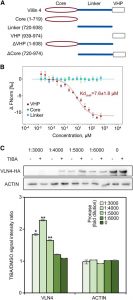Cytoskeletal Targets of an Auxin Transport Inhibitor
The phytohormone auxin plays critical roles in various plant developmental programs by controlling cell expansion and polarity, as well as organ  patterning. Auxin action relies on polar transport through different plant tissues. Auxin transport inhibitors are important tools for understanding auxin-dependent plant development. One mode of auxin transport inhibition involves actin dynamics. A major role of the actin cytoskeleton in auxin transport is to regulate vesicular trafficking of auxin efflux carriers of the PIN-FORMED (PIN) family. PIN proteins show a polar localization that determines the direction of auxin flow, and PIN targeting is a highly dynamic process with constitutive cycling between the plasma membrane and endosomal compartments. The actin cytoskeleton is required for both endocytosis and recycling of PINs. Zou et al. (10.1104/pp.19.00064) have characterized the action of 2,3,5- triiodobenzoic acid (TIBA) on actin dynamics. By means of live-cell imaging and quantitative analyses of actin dynamics, it was determined that TIBA increases actin filament abundance and bundling in root epidermal cells. Changes in actin organization resulted from reduced actin turnover and enhanced actin bundle formation. By surveying candidate actin-binding proteins mutants with reduced TIBA sensitivity, the authors determined that Arabidopsis (Arabidopsis thaliana) villins, a class of a Ca2+-dependent, actin-binding cytoskeletal proteins, contribute to TIBA action. TIBA-induced actin dynamics were altered in vln4 knockout mutants. TIBA directly binds to the C-terminal headpiece domain of VLN4 and promotes oligomerization of VLN4, leading to enhanced formation of actin bundles. These findings provide insights into the molecular mechanism by which villins contribute to the action of TIBA on actin cytoskeleton, supporting the important role of actin dynamics in the mechanism of auxin transport.
patterning. Auxin action relies on polar transport through different plant tissues. Auxin transport inhibitors are important tools for understanding auxin-dependent plant development. One mode of auxin transport inhibition involves actin dynamics. A major role of the actin cytoskeleton in auxin transport is to regulate vesicular trafficking of auxin efflux carriers of the PIN-FORMED (PIN) family. PIN proteins show a polar localization that determines the direction of auxin flow, and PIN targeting is a highly dynamic process with constitutive cycling between the plasma membrane and endosomal compartments. The actin cytoskeleton is required for both endocytosis and recycling of PINs. Zou et al. (10.1104/pp.19.00064) have characterized the action of 2,3,5- triiodobenzoic acid (TIBA) on actin dynamics. By means of live-cell imaging and quantitative analyses of actin dynamics, it was determined that TIBA increases actin filament abundance and bundling in root epidermal cells. Changes in actin organization resulted from reduced actin turnover and enhanced actin bundle formation. By surveying candidate actin-binding proteins mutants with reduced TIBA sensitivity, the authors determined that Arabidopsis (Arabidopsis thaliana) villins, a class of a Ca2+-dependent, actin-binding cytoskeletal proteins, contribute to TIBA action. TIBA-induced actin dynamics were altered in vln4 knockout mutants. TIBA directly binds to the C-terminal headpiece domain of VLN4 and promotes oligomerization of VLN4, leading to enhanced formation of actin bundles. These findings provide insights into the molecular mechanism by which villins contribute to the action of TIBA on actin cytoskeleton, supporting the important role of actin dynamics in the mechanism of auxin transport.



